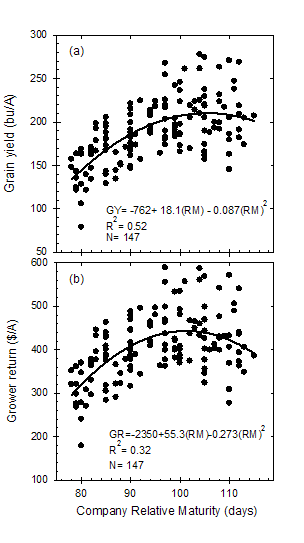August 2005
Field Crops 28.3-39
Optimum Relative Maturity for Yield and Profitability in Corn
Joe Lauer, Corn Agronomist
2016 PDF Version
2009 PDF Version
2005 PDF Version
Summary
- To ensure genetic diversity on your farm, select corn hybrids differing for relative
maturity (RM).
- Since 1929, corn hybrids to be sold in Minnesota were rated for maturity. The law
was repealed in 2003 and will be retired in 2006.
- No standard RM method exists in the corn industry.
- In southern WI, as RM increases, grain yield increases 2.2 bu/A. At a corn price
of $2.50 and drying cost of $0.02 per point moisture bushel, grower return increases
$4.00 /A for each RM unit.
- Optimum RM is variable in WI and depends upon many factors including location, soil,
management, corn price, drying method and hybrid traits.
- As a check, the company RM rating of every hybrid tested in the UW hybrid evaluation
program is compared against all other hybrids of the same maturity.
Relative maturity (RM) is determined by comparing grain moisture of hybrids at harvest.
Corn is mature when kernels reach maximum dry weight. Optimum RM depends upon the
harvest, use and storage methods on each farm. Corn for silage is ready as early
as 10 days prior to maximum kernel dry weight, while corn picked for grain is not
ready until grain moisture content reaches 23 to 28%.
Little data exists for corn relative maturity recommendations in Wisconsin. Our
objective is to determine the optimum relative maturity (RM) for corn at various
locations in Wisconsin.
How did we do the work?
Beginning in 1995, trials were conducted at Arlington, Chippewa Falls, Fond du Lac,
Hancock, Janesville, Lancaster, Marshfield, Seymour and Valders. Each trial consists
of two or more hybrids for each 5-day RM increment from 80- to 115-days for a total
of 14 to 16 hybrids per trial. The hybrids are top-performing hybrids selected from
the UW corn evaluation program. These hybrids change every year as well as the locations
of the trial. Yield, moisture and test weight were used to calculate the economics
of the RM decision.
Grower return was calculated by multiplying commodity price with yield and subtracting
production costs. Corn prices used were $2.00, $2.50, and $3.00 corn. The PEPS corn
price is more of a "real world" price annually determined using a marketing
strategy where 50% of the crop was sold in November and 25% forward contracted (less
basis) to March and July. The November average cash price was derived from Wisconsin
Ag Statistics, and the March and July future prices were derived from the Chicago
Board of Trade closing price on December 1 every year.
Harvesting costs were estimated for handling ($0.02 per bushel), hauling ($0.04
per bushel), trucking ($0.11 per bushel) and storage ($0.02 per bushel month with
25% of grain shipped in March after 4 months storage and 25% of grain shipped in
July after 8 months storage). For the livestock system, no trucking cost is assessed
and storage was $0.01 per bushel month. Drying costs were estimated at $0.00, $0.02
and $0.04 per point above 15.5% moisture per bushel for on-farm and commercial corn
production systems.
What have we found so far?
Longer-season hybrids have greater potential for higher yields at most locations.
In southern WI, as RM increases, grain yield increases 2.2 bu/A. At a corn price
of $2.50 and drying cost of $0.02 per point moisture bushel, grower return increases
$4.00 /A for each RM unit.
For example, at Arlington grain yield increases to a maximum around 106-days RM
(Figure 1a). At most locations, a significant relationship exists between grain
yield and RM. However, at Marshfield and Valders, no relationship between grain
yield and RM exists over multiple years of testing (Table 1).
The optimum relative maturity for grower return depends upon the corn drying method
(Table 2). The RM that optimizes grower return is different from the RM that optimizes
grain yield when drying costs are involved. For example, at Arlington using an on-farm
drying method, grower return is greatest with a corn hybrid RM of 101-days RM (Figure
1b and Table 2). At Marshfield, a 93-day hybrid optimizes grower return.
Although farmers generally get greatest yields by planting full-season hybrids early,
many short-season hybrids produce yields competitive with the best full-season hybrids
and are drier at harvest (Figures 1a and 1b).
Farmers need to consider the economic tradeoff between yielding ability and drying
costs for hybrid maturity. Full-season hybrids provide the greatest potential for
maximizing yield and profitability. Plant several hybrid maturities each year to
spread the harvest season and reduce the risk of losses from moisture stress at
pollination time or early frost.
Traditionally, the mix of hybrid maturities grown on a farm vary according to the
risk one is willing to assume (i.e. 25% of acres grown to full-season, 50% to mid-season,
and 25% to short-season maturities). Others recommend mixing hybrid maturities according
to the type of environment predicted. The best approach may be to select hybrid
maturities based solely on the intended use and drying method in the production
system.

Figure 1. The relationship of relative maturity with a) grain yield and b) grower
return ($2.50 corn price, on-farm drying) at Arlington, WI (1995-2004).
|
Table 1. Optimum relative maturity (days RM) for grain yield at various locations
in WI.
|
|
Location
|
Years tested
|
Optimum RM
|
|
Arlington
|
1995-2004
|
106
|
|
Janesville
|
1996-1997
|
107
|
|
Lancaster
|
1996-1997
|
112
|
|
Fond du Lac
|
1996-1997
|
103
|
|
Hancock
|
1995-2004
|
104
|
|
Chippewa Falls
|
1999-2001
|
104
|
|
Marshfield
|
1999-2004
|
---
|
|
Seymour
|
1999-2001
|
102
|
|
Valders
|
1999-2001
|
---
|